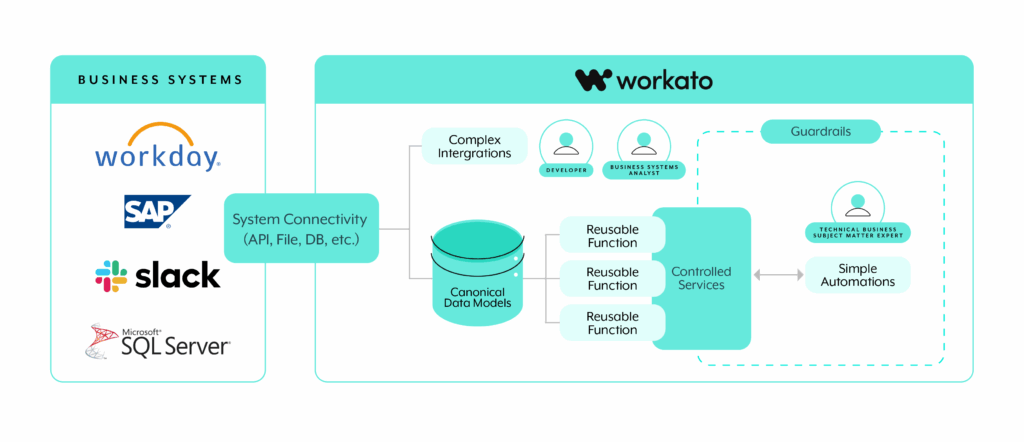Navitas is Australia’s largest independent education provider and a global leader in education. With over 5,000 employees and a vast international network spanning 16 countries, Navitas has pioneered partnerships with 39 universities to provide over 60,000 learners access to life-changing educational opportunities. Operating and expanding at this scale inevitably taxed the centralised IT team, who managed and built all integrations throughout Navitas – both core integrations used by all colleges as well as bespoke integrations that are only specific to certain colleges or divisions.
Armed with 8 years of integration experience, Rob Shepherd, Solution Architect at Navitas, knew that the solution was not just going to be about adopting an integration platform-as-a-service (iPaaS) that empowers him and the Corporate IT team, but about catalysing a shift in the very way Navitas innovates, while ensuring robust governance. This is their story of transforming IT architecture and setting a new standard in the competitive global education market.
Bottlenecked Central IT, Security Risks of Shadow IT
Navitas’s corporate IT team was overwhelmed with integration requests from various departments and partner institutions, creating a 2-year backlog that hindered their ability to respond quickly to market changes or launch new educational programs efficiently.
With the corporate IT team bottlenecked and caught up with building custom integrations on tools like JBoss and IBM App Connect, it was wishful to expect real-time data sharing between systems, leading to delays in critical processes. Delivering data to a strategic partner meant submitting an IT request, waiting in a queue, and hoping for turnaround in time.
For instance, launching new educational programs or entering new markets was a lengthy process due to IT dependencies. Partner universities could not get timely updates on student data, affecting decision-making and student support. Limited real-time reporting capabilities affected both internal operations and partner relationships.
Worse still, to avoid having to wait for their needs to be met, staff had begun to use tools that were not sanctioned by the corporate IT team, creating what is known as a shadow IT problem – a huge security risk for Navitas. Teams wanted to be able to independently handle their integration needs but there was no way for the corporate IT team to securely expose data and enable access in a governed way.
Empowering Global Teams to Integrate and Innovate
Rob and the Corporate IT team set out in search of an iPaaS solution that could offer the best of both worlds – democratised innovation and robust governance. They prioritised the need to empower citizen integrators rather than maintaining centralised IT as status quo, even though this meant reinventing their IT organisation.
The team ultimately chose Workato over other low-code options like Boomi and Microsoft Power Apps due to the platform’s ease of use, integration prowess, and how well it would enable their vision to decentralise IT. This included central governance, consistent application of best practices to non-core integrations, and the ability to allocate costs to different divisions, rather than the corporate entity alone.
Navitas first put Workato into action through the groundbreaking “Data Services Layer” project, which empowers Navitas’s colleges to seamlessly manage their own data with the student lifecycle.
Here’s how it works:

- Using Workato’s Event streams, Navitas is able to channel core events into the system, and use the event lifecycle to synchronise with every prospective students’ lifecycle of events.
- This standardises data on Navitas’s end and creates a modularised event streaming experience for partner colleges; they can pick from a menu of core events to manage their own unique student lifecycle, from start to finish.
- The system seamlessly pulls out each student’s course information and personal information like identification details, which were pre-assigned by the partner college, and Workato syncs this data with Navitas’s records.
Beyond student lifecycle management, Navitas’s University Partnerships Europe (UPE) team has also managed to use Workato to implement real-time document verification workflows, accelerating visa processing for students.
Speed, Empowerment and Governance
Here’s what Navitas achieved with Workato:
- 6-18x increase in integration velocity: Integrations that were stalled for 6-7 months could now be fixed and deployed in just 1 week. So instead of taking an entire year, Navitas rolled out 6 integrations within 2 months.
- Eliminated bottlenecks: Empowered each college and division to handle their own integrations and make changes to it, eliminating the central IT bottleneck. Navitas’s in-house developers have even elevated their role to support and offer professional services to teams who need help throughout the organisation.
- Enhanced productivity: Staff can build automation workflows (i.e. recipes) in a couple of days instead of weeks, and go through the Quality Assurance process in a couple of weeks instead of months, significantly improving productivity.
- Governance, visibility and consistency: Through Workato’s Automation HQ, several partner universities were able to spin off their own instances that fully adhere to security and compliance requirements set by corporate IT. This provides visibility, and a foundation for eliminating shadow IT. Navitas was also able to build re-usable assets and a consistent data standard that gets adopted across the board.
Shaping The Future of Higher Education
Armed with Workato, Navitas has not only overcome its immediate challenges but has also positioned itself for future growth and innovation. Looking to the future, Rob shares that his team has set their sights on completely eliminating shadow IT across Navitas, and on automating several processes to elevate both student and staff experience. With a decentralised agile operation powered by Workato, Navitas continues to push the boundaries of what is possible in global education.


